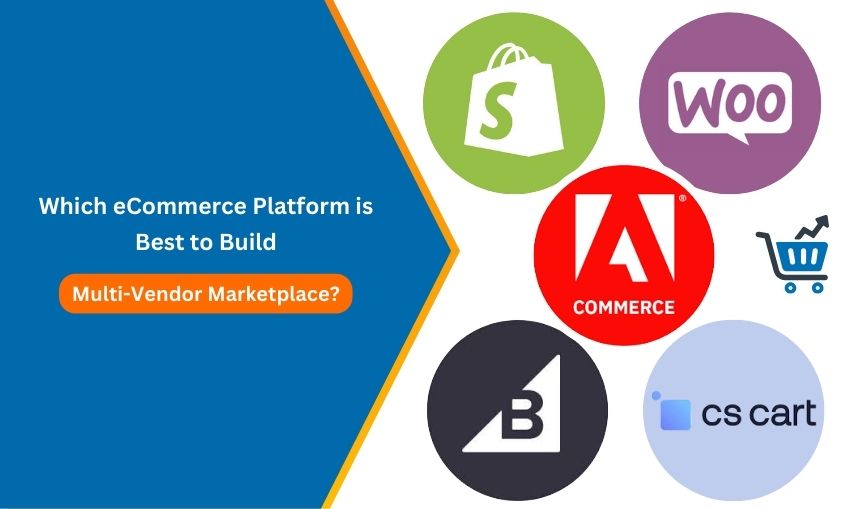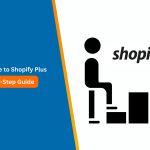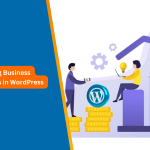A multi-vendor marketplace is an online marketplace where multiple sellers come together to sell their products and services. The Internet is filled with popular multi-vendor marketplaces, like Etsy, Amazon, eBay, and Flipkart. The total worldwide spending is expected to reach $6.8 trillion in 2025, and around 2/3rd of the global online sales happen through marketplaces.
Launching a multi-vendor marketplace is the best option in comparison to a traditional eCommerce store because you don’t have to purchase, store, or manage inventory. You will have to onboard vendors, and as the number of vendors increases, your product catalog and revenue potential grow without a proportional increase in operational workload.
For building a multi-vendor marketplace, you need an eCommerce platform that is reliable, flexible, and solid on the backend. You need something that actually helps you manage multiple vendors and thousands of SKUs. At the end of the day, the platform must assist in order routing, commission models, and real-time analytics without making you lose your mind.
However, once you start comparing platforms, you will realize fast that the best answer depends on more than just branding or who has the comprehensive dashboard. So let us break this down properly.
Why Choosing the Right Platform Is Crucial from Day One?
Once your marketplace is live and vendors are on board, changing platforms is not just a hassle. It is a full-blown migration nightmare. You are moving product catalogs, redoing integrations, retraining vendors, and resetting SEO.
So, if your foundation is shaky, everything you build on top becomes fragile. That is why choosing the right eCommerce platform early on is a decision that can either set you up for growth or become the thing you keep fixing every six months.
Whether you are building a niche community marketplace or a full-scale Amazon alternative, the platform you pick will decide how much you can automate, how fast you scale, and how painful your daily operations feel.

See How Our Experts Can Drive More Traffic to Your Website!
SEO: Boost your rankings and drive more organic traffic today!
Website Design/Development: Create a stunning website that converts visitors into customers.
Paid Media: Reach the right audience at the right time with expertly managed paid media.
Core Features You Actually Need in a Multi-Vendor Platform
Before you even look at eCommerce platform names, make sure you have a checklist of the features that matter. For instance, here are some important factors that your eCommerce platform should have to support multi-vendor marketplace development:
- A dedicated vendor dashboard for each seller
- Flexible commission structures
- Order management and fulfillment split across vendors
- Vendor reviews and ratings
- Role-based access for admins, vendors, and managers
- Integration with payment gateways that support vendor payouts
- Scalability and customization options
Top 5 eCommerce Platforms to Build a Multi-Vendor Marketplace
Here are five platforms that you can actually use when you want to get real work done:
1. Shopify with Multi-Vendor Apps: Quick to Launch, Limited Depth
If your goal is to get something live quickly and you do not need too much customization early on, then Shopify is often where people start. With apps like Multi-Vendor Marketplace by Webkul or Multi-Seller Marketplace, you can turn a basic Shopify store into a marketplace.
Pros
- Easy to set up without needing developers
- Clean vendor dashboards through third-party apps
- Fast onboarding for sellers with minimal training
- Good support ecosystem for plugins and tools
- Integrates well with payment gateways
Cons
Shopify is not built natively for multi-vendor workflows. Most features you need for scale will rely heavily on apps. That means extra cost and configuration headaches. You will probably need help from a Shopify development company to keep everything stable when orders grow.
2. WooCommerce with Plugins: Great Flexibility, High Maintenance
If you are comfortable with WordPress and need a solution that gives you more control, WooCommerce with a plugin like Dokan or WCFM Marketplace is a strong contender.
Pros
- Full control over vendor management and shipping
- Flexible commission structures and payout settings
- Easily customizable for unique workflows
- Open source with huge plugin support
- Strong community for troubleshooting and documentation
- Works well for multichannel ecommerce for WooCommerce setups
Cons
You will need ongoing help to maintain the site, especially when plugin updates break things or create conflicts. Without a WooCommerce development company on hand, this flexibility becomes a maintenance headache.
3. Magento or Adobe Commerce: Enterprise-Level Power, Steep Setup
If you are building a serious platform with thousands of vendors, enterprise workflows, and heavy traffic from day one, then Magento, also called Adobe Commerce, should absolutely be on your list.
Pros
- Deep backend control and performance tuning options
- Supports multiple storefronts and vendor groups
- Advanced features for tax, inventory, and user roles
- Powerful reporting and analytics features
- Strong plugin ecosystem for enterprise features
Cons
You will need technical help from day one. Most businesses work with a Magento web design company to get their initial build stable. It is overkill if you only want to test a small marketplace idea.
4. BigCommerce: Cleaner UX, But Less Marketplace Support
BigCommerce is known for being cleaner and more modern in terms of UX. It handles headless builds better than most beginner platforms.
Pros
- Modern and fast user experience for buyers
- Integration with Facebook, Instagram, and Google Shopping for multi-channel eCommerce marketing
- Clean code and structure are good for SEO
- Decent performance out of the box
- It can support custom APIs and third-party tools
Cons
Multi-vendor functionality is not well supported unless you build it yourself or find niche apps. It is not a great fit for non-technical founders who want prebuilt solutions.
5. CS-Cart: Built for Multi-Vendor Use Cases Only
If your only goal is to build a multi-vendor marketplace and you are not trying to repurpose a traditional eCommerce platform, then CS-Cart Multi-Vendor is one of the most focused solutions out there.
Pros
- Built from scratch for multi-vendor workflows
- Built-in vendor dashboard, payout, and shipping
- Supports vendor subscription and onboarding flows
- No need for dozens of extra plugins
- Decent pricing model for growing marketplaces
Cons
It is not as flexible or widely supported as open-source platforms like WooCommerce. Developer availability is also limited unless you use ecommerce development services familiar with CS-Cart.
How to Choose a Platform?
The platform you choose becomes the backbone of your digital business, and it affects everything —from user experience and payment processing to scalability, security, and long-term expansion. So, while you have different options available, let’s understand the critical factors you must consider to make a well-informed decision:
- Ecosystem Integration Should Not Be an Afterthought
Choosing the right platform is not just about the storefront or vendor features. It is also about how well the platform plays with your backend tools, including ERP, inventory, shipping, tax engines, and payment gateways. If you need Shopify Multichannel Integration to sync inventory across retail and online, make sure the platform can handle that with minimal breakage.
Also, if you are planning to scale, think about how hard it will be to hire developers or get support. Hiring someone to manage WooCommerce is usually easier than finding someone who specializes in CS-Cart or custom BigCommerce workflows. If you plan to hire eCommerce developers, make sure your stack is not too obscure.
- SEO and Paid Ads Also Depend on the Platform Structure
Multi-vendor marketplaces need proper content structure and clean product URLs. If your platform creates messy product slugs or duplicates, your SEO performance will tank fast. That is why many founders work with an SEO agency that understands the difference between static pages and dynamic product feeds.
You should also consider how your platform integrates with ad systems. If you plan to run Google campaigns and work with an AdWords management company or Amazon PPC experts, your marketplace should allow clean product feeds, proper tagging, and real-time inventory sync, especially if you plan to experiment with types of Google Ads beyond just shopping campaigns.
- Inventory Management and Fulfillment Logic Can Make or Break Operations
One thing most people overlook early on is how the platform handles inventory across multiple sellers. If one vendor runs out of stock and the system still accepts orders, you are dealing with refunds and frustrated customers. That is why your platform must support vendor-level inventory control. It must let each seller manage their product quantities while still syncing with the central system in real time.
It also needs to support flexible shipping logic. For example, if a customer places an order with products from three vendors, the system should split those shipments correctly. This is where platforms like Adobe Commerce and CS-Cart stand out. They have stronger inventory orchestration features compared to Shopify or BigCommerce. Without this level of control, your customer experience will suffer, and your support team will stay overwhelmed.
- Analytics and Reporting Matter When You Start Scaling
At first, you may not think much about dashboards or reports. But once you have fifty vendors, two hundred orders a day, and customer service calls coming in nonstop, you will need strong reporting tools. Your platform must let you track sales by vendor, revenue by category, commission earnings, refund trends, shipping delays, and more.
This is not just about pretty charts; in fact, this is about understanding what part of your marketplace is actually working and where you are bleeding time and money. Many platforms offer basic dashboards, but if you want detailed reports or export-ready data, you will need something built for scale.
A Shopify Plus development company can sometimes help you enhance reporting through third-party apps or custom APIs. However, if that feels like too much effort, WooCommerce and Magento might be better starting points if data matters deeply to your business model.
Final Verdict
- Start with Shopify if you want to launch quickly and test a niche idea. However, be ready to hit limits if you grow fast.
- Go with WooCommerce if you want control, plugin variety, and flexibility, but you will need help maintaining it.
- Choose Magento if you are already operating at scale and want full backend depth. The setup will take time, but you get power.
- Use CS-Cart if your only focus is building a marketplace, and you want something made specifically for that purpose.
- Skip BigCommerce unless you are prepared to build most of the marketplace logic yourself or hire a strong dev team.
The bottom line is that there is no universal best platform. The right choice depends on your budget, your growth plan, and how comfortable you are building on top of the tech.
If you are building a multi-vendor marketplace, the platform you choose will shape everything that follows. Right from vendor onboarding to daily operations, stability matters more than speed. Icecube Digital helps you make decisions that hold up as your business scales. Let’s talk when you are ready to build something that works from the ground up.






